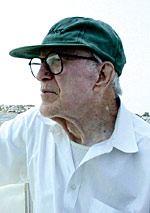Britton Chance
DOI: 10.1063/PT.3.1339
Britton Chance’s career was driven by the physics of electronics, radiation, and mechanics applied to revealing fundamental mechanisms of biology and physiology and later to developing noninvasive optical devices for medical imaging and clinical diagnostics. His life was fueled by what seemed to be such an inexhaustible source of energy that many regarded his death of heart failure in his 98th year, on 16 November 2010, as premature.
Chance was born on 24 July 1913 in Wilkes-Barre, Pennsylvania, into a family of inventors and engineers who loved ocean sailing. For him, sailing became a lifelong passion. At age 13 he was licensed as a radiotelegraph operator. At 15, while at Haverford School in Philadelphia, he invented an automatic steering device for ships: A tungsten light beam was reflected from a mirror on the tip of a compass needle onto photodetectors that registered motion and used electrical feedback signaling to alter steering.
During the 1930s at the University of Pennsylvania, where he did his undergraduate and graduate work in physical chemistry, he again brought together optics, mechanics, and feedback control in his invention of a stopped-flow spectrometer, now standard research instrumentation for measuring rapid kinetics in chemistry and biochemistry. He further developed his ship’s steering device over the same time, and in 1938 the 25-year-old Chance was offered a contract with General Electric in the UK to supervise its installation in a 20 000-ton refrigerator ship and test it on a three-month voyage between England and Australia.
While in the UK, Chance was accepted to study under Hamilton Hartridge, Francis Roughton, and Glenn Millikan, physiologists at Cambridge University who were studying rapid interactions of oxygen with hemoglobin. In that first taste of biology, he found himself working in the same laboratories as neurophysiology giants Alan Hodgkin and Andrew Huxley. Huxley noted that Chance “spent part of his time adding a photoelectric detector to Roughton’s apparatus and the rest of it in developing a servo pick-off from a magnetic compass as part of an automatic pilot for a sailing boat; both these activities led on to fields in which he later became world famous.”
In the next five years, Chance graduated with PhDs from Penn in physical chemistry (1940) and Cambridge in physiology (1942). In 1940, with World War II under way in Europe, he returned to the US to become acting director of the Eldridge Reeves Johnson Foundation, which is devoted to biomedical physics, at the University of Pennsylvania’s medical school. However, in 1941, already recognized for his exceptional skills in optics, electronic timing, and servomechanisms, particularly low-frequency phenomena, he was tapped by the physicists for the radar project at MIT. By 1942 Chance had moved through the ranks of the Radiation Laboratory to become a member of its prestigious steering committee. He led a group of 300 mainly young physicists in developing precision circuits to record submicrosecond time delays between a microwave radar pulse and its echo. His group introduced computers to provide ranging information for defending antiaircraft guns and a ground-positioning indicator aboard attacking bombers.
In 1947, on a Guggenheim fellowship with Hugo Theorell in Stockholm, Chance extended his own groundbreaking PhD work by demonstrating that enzymes and substrates first form a complex and retain intermediate states before releasing the products.
At 36 Chance returned to Penn to become director of the Johnson Foundation. Committed to biology, he designed many novel instruments to rapidly measure minute optical changes, often against a highly scattering background. As many scientists from around the world flocked to the Johnson Foundation to use them, Chance plowed ahead over the next three decades to make one discovery after another. Key among them was his finding that biological electron transfer is governed by quantum mechanical tunneling, a mechanism that underpins energy conversion and catalysis in photosynthesis, respiration, and related oxidoreductases. In those systems he revealed electron transfer sequences, their energy coupling to phosphorylation, and, not surprising, feedback mechanisms that regulate energy conversion. For mitochondrial analyses in laboratories and clinics, Chance laid down the markers that remain essential descriptors for assessing health, aging processes, and diseases.
In his late 60s, Chance turned to the use of spectroscopy to track cellular metabolism and energetics deep in live tissue. First he conducted pioneering studies of phosphorous nuclear magnetic resonance, and then at 78 he returned to his forte of developing small, inexpensive electro-optical instrumentation. Chance’s new instruments exploited the physics of light diffusion through scattering materials, rather than minimizing the effects of light scattering as in his early spectrophotometers. Over the past two decades, it has become increasingly clear that scattered near-IR light pulses can report the metabolic energy status in performing muscles, locate tumors and cancerous tissue in muscles and breast, and access cognition and injury in the brain. Chance’s legacy is a burgeoning field of biomedical optics and biophotonics.
Recently Chance commented that he felt he had come full circle in applying microsecond microwave radar technology to picosecond optical ranging in the human frame. From his earliest days at MIT, he appreciated physicists’ straightforwardness. Looking back over his career Chance reflected, “It’s a good thing to have the physics community behind a biophysicist!”

Britton Chance
HIDEAKI KOIZUMI

More about the Authors
P. Leslie Dutton. Eldridge Reeves Johnson Foundation Philadelphia.
